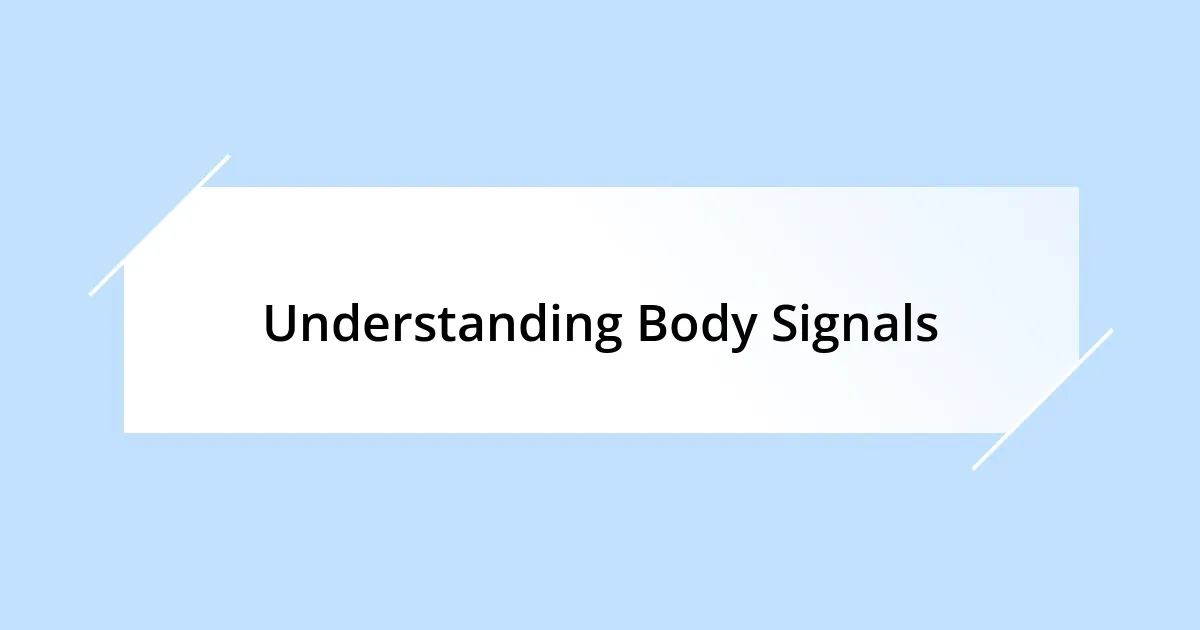Key takeaways:
- Listening to body signals, such as fatigue or discomfort, can lead to a better understanding of personal needs and well-being.
- Mindfulness practices enhance bodily awareness and emotional well-being, creating a deeper connection between mind and body.
- Tracking daily patterns of mood, nutrition, and activity helps identify triggers and promotes healthier habits.
- Adapting routines based on body cues fosters a more balanced and joyful lifestyle, enhancing overall health.

Understanding Body Signals
Every day, our bodies communicate with us, often in subtle ways. I remember a time when I brushed off a persistent ache in my shoulder, thinking it was just stress. But when I finally listened, I realized it was my body urging me to change my posture and reduce my screen time. Can you think of a time when ignoring a body signal led to unexpected discomfort for you?
It’s fascinating how certain signals can be easily misinterpreted. I once felt constant fatigue and attributed it to a busy lifestyle. It wasn’t until I acknowledged my need for sleep and nourishment that I truly felt energized. Have you ever stopped to consider what your cravings or tiredness might be telling you about your needs?
Learning to differentiate between various signals took time for me. I found it illuminating to note how anxiety would manifest as a tightness in my chest, while excitement would create a fluttering sensation. It’s almost as if our bodies have a language of their own—did you ever wonder what stories your body is trying to tell you throughout the day?

Recognizing Physical Discomfort
Recognizing physical discomfort can often feel like deciphering a secret code. I recall a time when I dismissed a dull headache as a typical response to a long workday. However, after tuning in more closely, I discovered that I had been neglecting my hydration. This simple adjustment made a world of difference, reminding me how our bodies often cry out for basic needs that we sometimes overlook.
In a similar vein, I remember experiencing tightness in my lower back. It was an uncomfortable, nagging sensation that I tried to ignore while pushing through my daily activities. It wasn’t until I gave myself permission to rest and assessed my posture that I learned this discomfort was a clear indication that my body needed a break and some gentle stretching. Don’t you find it interesting how physical discomfort can often lead us to revelations about our daily habits?
Physical discomfort can manifest in various forms, and being attuned to these nuances is essential. For instance, I used to mistake mild stomach cramps for hunger, only to realize later that they were my body signaling stress. Once I acknowledged this, I began practicing mindfulness techniques to manage stress more effectively. Recognizing these signals is not just about the pain; it’s about understanding the stories behind them.
| Type of Discomfort | Possible Cause |
|---|---|
| Headache | Dehydration or eye strain |
| Lower back tightness | Poor posture or prolonged sitting |
| Stomach cramps | Stress or digestive issues |

Exploring Mind-Body Connection

Exploring Mind-Body Connection
When I started to really understand the mind-body connection, it was like finally tuning into a radio station I had previously ignored. I recall a yoga class where the instructor emphasized the importance of being present in each pose. As I focused on how my body felt in each position, I noticed a profound shift in both my physical and emotional state. This experience opened my eyes to how interlinked my mental well-being and physical sensations truly are.
Here are some insights I gained along the way:
– Emotional responses can trigger physical sensations. I’ve often felt a knot in my stomach before a big presentation, reflecting my anxiety.
– Mindfulness practices enhance bodily awareness. Incorporating mindfulness into my routine helped me become more attuned to my body’s needs, reducing my instinct to push through discomfort.
– Breath has a transformative power. I found that simply taking deep breaths during stressful moments can alleviate not only my anxiety but also physical tension in my muscles.
It’s intriguing how little habits can impact our overall well-being. For instance, there was a period when I used caffeine as a crutch to power through my days. Yet, every time I felt jittery or anxious after my third cup, my body was clearly signaling for balance. Once I reduced my intake, I was struck by how much calmer and more focused I felt throughout the day. These revelations highlight the need to listen carefully to what our bodies are saying, prompting a deeper inquiry into our daily choices.

Tracking Daily Patterns
Tracking my daily patterns was a game changer in learning to listen to my body. I started by jotting down notes about how I felt each day, what I ate, and my activity levels. It was interesting to see the direct correlation between my fatigue and those late-night snacks. Have you ever noticed how your energy dips after an indulgent evening? I realized that keeping track allowed me not only to identify triggers but also to make informed adjustments.
There were days when I recorded low energy levels despite a full night’s sleep. It perplexed me until I noted my stress levels correlated with those days. I began to look deeper, and that’s when I discovered how emotional strain can affect physical well-being. It’s amazing how stress can be the invisible heavyweight on our shoulders, crippling our energy without us even realizing it. Have you ever felt drained without a clear reason? This realization illuminated the importance of holistic tracking.
One practice that worked well for me was syncing my tracking with my mood. On days when I felt anxious, I’d note my hydration and nutrition, leading me to understand how my body responds to different stimuli. It was eye-opening to see that simple things, like skipping breakfast, could make me feel more agitated later on. It’s like peeling back layers to reveal a more complete picture of my health. By tracking these daily patterns, I developed a personal roadmap that truly guided me toward a more balanced lifestyle.

Implementing Mindful Practices
Implementing mindful practices has transformed my approach to daily life. One practice I found particularly helpful is mindful walking. Instead of racing through my errands, I focused on the sensation of my feet hitting the ground and the rhythm of my breath. Have you ever stopped to notice the world around you? I began to appreciate small details, like the warmth of the sun or the sounds of birds, which anchored me in the present moment and made me feel more connected to my surroundings.
Incorporating meditation into my routine was another significant step. Initially, I struggled with sitting still for even five minutes—my mind would race through endless to-do lists. But gradually, I learned to acknowledge those distracting thoughts without judgment. That realization sparked a profound shift for me. It was like creating space in my mind, allowing clarity to emerge. How often do you find yourself overwhelmed by your thoughts? This practice taught me the importance of quieting my mind and tuning into my body’s sensations, leading to a deeper understanding of my emotional state.
Finally, I started to practice gratitude every evening by reflecting on my day. This simple ritual made me appreciate even the smallest joys, like a warm cup of tea or a friendly conversation. Have you ever noticed how gratitude shifts your perspective? By focusing on the positives, I found that my body felt lighter and my stress levels diminished. This daily practice not only grounded me but also helped me listen to what my body needed—be it rest, movement, or just a moment of stillness. Through these mindful practices, I’ve cultivated a more profound connection with myself, and I encourage you to explore what resonates with your unique journey.

Adapting Healthy Routines
Adapting healthy routines has been a journey of trial and error for me. One of the first changes I made was to establish a morning ritual that suited my needs. Instead of rushing through breakfast while scrolling on my phone, I began savoring my meals mindfully, truly tasting each bite. I noticed that taking those few moments to be present not only enhanced my meals but also set a positive tone for my day. Have you ever felt that a small shift in your routine could lead to a drastic change in your mood?
As I delved deeper into my body’s signals, I realized the value of consistency in my exercise routine. Instead of following strict workout plans that left me feeling drained, I focused on mixing things up based on my energy levels. Some days, a brisk walk or gentle yoga felt right, while other days called for a more intense workout. This adaptability allowed me to listen to what my body craved, transforming exercise from a chore into a delightful practice. How freeing is it when you can exercise joyfully instead of forcefully?
I also found that sleep hygiene played an essential role in adapting my routines. Initially, I had a habit of binge-watching shows late into the night, disregarding how that affected my sleep quality. After experimenting with winding down with a good book instead, I noticed I transitioned into sleep much more smoothly. It dawned on me that prioritizing rest is just as vital as any other aspect of health. Have you ever discovered that what you thought was just a habit was actually holding you back? Making these adjustments has not only strengthened my routines but has also reinforced my connection to my body’s natural rhythms, leading to a more harmonious life.

Evaluating Progress and Adaptation
Evaluating my progress and adapting my practices has been an ongoing exploration. I remember a moment when I realized I had unintentionally skipped my mindfulness routine for a week. Instead of feeling defeated, I took a step back to assess why that happened. Could it be that life simply got too busy? Recognizing those patterns became a tool to adjust my approach, allowing me to create a more sustainable routine that truly supports my well-being.
Feedback from my body emerged as my most reliable compass. I started keeping a journal to document how I felt physically and emotionally after various activities. What surprised me was how much my energy levels fluctuated based on my choices. On days when I chose to nourish myself with whole foods, I felt vibrant and alive. Conversely, indulging in quick snacks only yielded sluggish afternoons. Isn’t it fascinating how our bodies communicate with us when we take the time to listen?
As I evaluated my progress, I also learned to celebrate the small victories, no matter how trivial they seemed. I remember the joy I felt when I not only completed a long walk but actually found myself smiling during it. It was a simple acknowledgment of my efforts but it felt monumental at that moment. Have you ever paused to acknowledge the progress you’ve made, even if it’s just getting through a tough day? This habit of self-reflection has propelled me forward, helping me adapt and evolve in tune with what my body is telling me.














